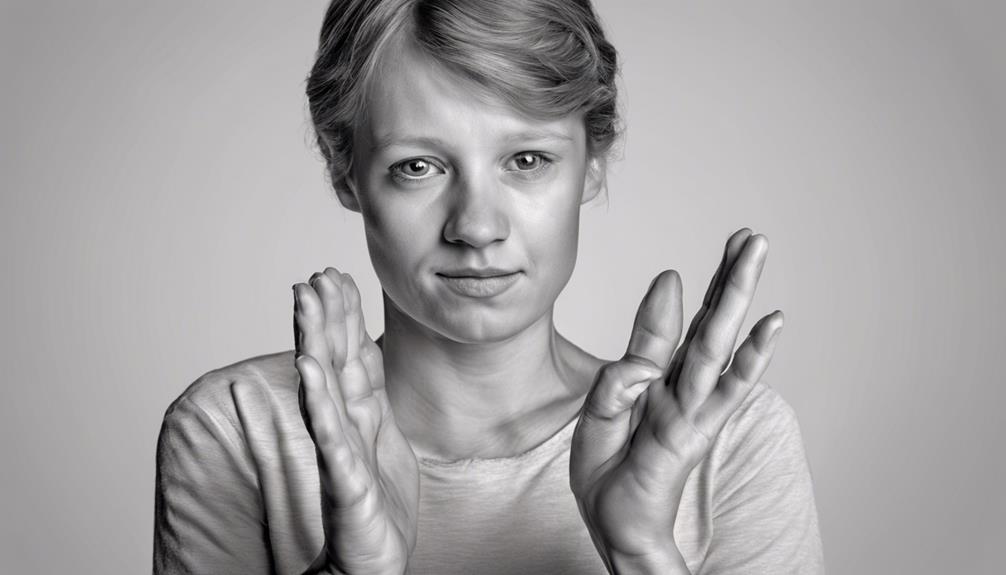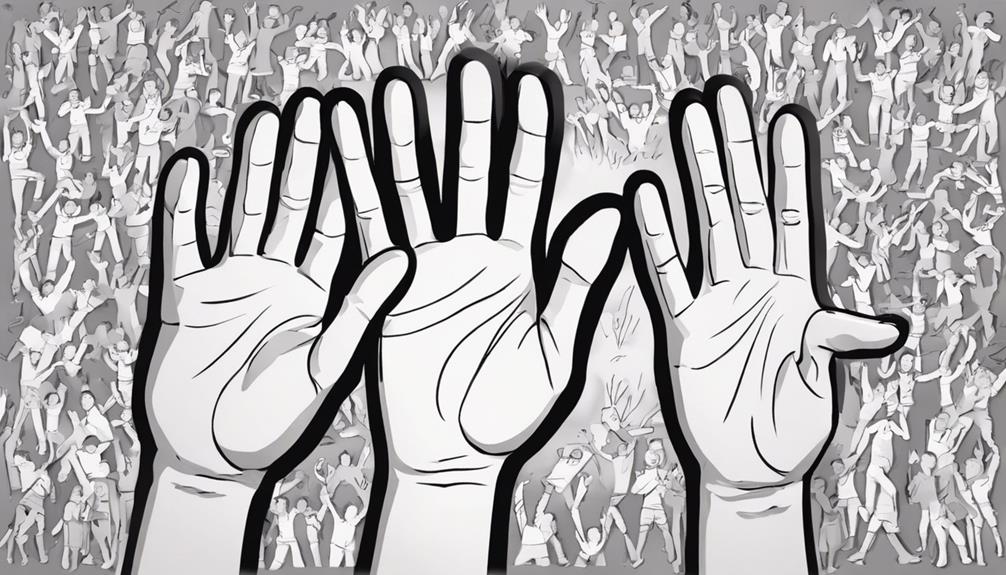When we use sign language to extend our hands, we are not only conveying words; we are demonstrating a profound connection.
Have you ever wondered how to convey the simple yet profound question, 'How are you,' through hand gestures?
Understanding the subtleties of sign language greetings can open doors to meaningful interactions and bridge communication gaps.
Let's explore the art of signing 'How are you' and delve into the nuances that enrich this form of expression.
Key Takeaways
- Master basic sign language gestures for effective communication.
- Understand the cultural significance of sign language phrases.
- Practice regularly to enhance fluency and confidence.
- Utilize feedback and interactive activities for improved learning outcomes.
Importance of Learning Sign Language Greetings
Learning sign language greetings, such as 'how are you,' is crucial for fostering inclusivity and communication within the Deaf community. When we take the time to learn sign language, we show our commitment to inclusivity and respect for the Deaf culture.
Mastering common signs for greetings not only aids in basic communication but also builds bridges to form meaningful relationships. By understanding these fundamental signs, we open ourselves up to deeper connections and a greater understanding of the Deaf community.
Sign language greetings go beyond just words; they demonstrate empathy and appreciation for different modes of communication, promoting diversity and understanding. It's through practicing these signs that we can enhance social interactions and create a more inclusive environment for everyone.
Therefore, taking the initiative to learn sign language, especially common signs for greetings, is a significant step towards promoting inclusivity and communication within the Deaf community.
Basic Gestures for Asking 'How Are You

As we delve into basic gestures for asking 'How Are You' in sign language, it's essential to understand the foundational signs and techniques required for effective communication in American Sign Language (ASL).
- Use a rolling motion with fists together and thumbs up to sign 'how', followed by pointing to signify 'you' in ASL.
- The sign for 'how are you' in ASL involves combining the signs for 'how' and 'you' to inquire about someone's well-being.
- Practice signing 'how are you' to greet or inquire about someone's condition in ASL.
- Incorporate facial expressions and appropriate body language while signing 'how are you' for effective communication in ASL.
- Understanding basic gestures and signs is essential for asking 'how are you' in sign language effectively.
Mastering these fundamental signs and techniques will enhance your ability to connect with individuals using sign language, fostering better communication and understanding in the process.
Cultural Context of Sign Language Phrases
Exploring the cultural context of sign language phrases like 'How are you' unveils the rich tapestry of connections and nuances embedded within the Deaf community. The first sign, where hands are extended forward, signifies more than just a casual greeting; it reflects the deep-rooted cultural significance of communication within the Deaf community.
Understanding the cultural context of sign language phrases not only enhances communication but also fosters inclusivity and respect for Deaf culture. Sign language isn't merely a series of gestures but a language that carries with it a sense of identity and belonging.
Different communities may interpret sign language phrases in unique ways influenced by their cultural backgrounds. By learning about the cultural context of sign language phrases, we can develop a greater appreciation for the richness and diversity of Deaf culture and communication. This knowledge promotes respectful interactions and strengthens connections within the Deaf community.
Tips for Improving Sign Language Communication

To enhance sign language communication, we should focus on practicing facial expressions and body movements to effectively convey emotions. In American Sign Language (ASL), facial expressions play a crucial role in indicating tone, emotion, and emphasis. Here are some tips for improving sign language communication:
- Utilize handshapes and gestures: Incorporate a variety of handshapes and gestures to enhance the clarity and meaning of your signs.
- Pay attention to hand positioning: Ensure proper hand positioning and movements to accurately communicate in sign language.
- Engage in regular practice: Practice regularly to improve fluency and confidence in signing.
- Seek feedback: Ask fluent signers for feedback to refine your signing skills and enhance communication.
- Use body movements: Incorporate body movements to complement your signs and convey additional meaning effectively.
Practice Makes Perfect: Mastering Sign Language Greetings
Regular practice is essential for mastering sign language greetings, ensuring fluency and proficiency in conveying simple yet meaningful interactions. By engaging in consistent practice, individuals can improve their fluency in American Sign Language (ASL) greetings and feel more confident in their ability to communicate effectively.
One helpful tip is to model the correct signing technique for greetings like 'how are you', demonstrating the movements and gestures clearly for others to follow. Encouraging interactive activities that involve greeting others using sign language can also enhance learning and retention of these essential phrases.
As you practice signing 'how are you' by rolling your fists forward with thumbs up and pointing to signify 'you', remember that each sign flows into the Next sign seamlessly, creating a fluid and natural conversation. Providing opportunities for feedback and reinforcement can further solidify understanding and mastery of sign language greetings.
With dedication and regular practice, you can become fluent in ASL greetings and make meaningful connections through sign language communication.
Frequently Asked Questions
How Do You Say How Are You Doing in Sign Language?
We can express 'how are you doing' in sign language by combining signs for 'how' with rolling fists and 'you' by pointing. These dynamic hand movements and facial expressions effectively convey the question's tone in American Sign Language (ASL).
Learning these signs enhances communication skills and fosters inclusivity when interacting with Deaf individuals. Practicing ASL signs for 'how are you doing' helps initiate conversations and build connections through a shared language.
How Do You Say Hello How Are You in Sign Language?
Sure thing!
In sign language, saying 'hello, how are you?' involves combining the signs for 'hello' and 'how are you'.
It's important to remember the specific hand movements and facial expressions for clear communication.
Practice and patience are key to mastering sign language greetings.
Learning to sign greetings in ASL can greatly improve our interactions with the Deaf community.
How Are You in English Sign Language?
Sure, in English sign language, we can sign 'how are you' by combining the signs for 'how' and 'you' in a specific sequence. It involves rolling our fists together with thumbs up and then pointing to signify 'you.'
ASL grammar and facial expressions are essential for effective communication. Practicing hand movements and facial expressions will help us convey 'how are you' accurately in ASL, fostering better communication with Deaf individuals.
How Do You Say How Are You Feeling in Sign Language?
We often express concern by asking 'How Are You Feeling?' in American Sign Language. This question involves signing 'how' with rolled fists and a pointed gesture towards the person. The facial expression with furrowed eyebrows signifies a question.
ASL grammar nuances in the sign 'how' can convey inquiring about manner or condition. Consistent hand movements are crucial for effective communication. ASL offers a visual and empathetic way to check on someone's well-being.
Is “You’re Welcome” in Sign Language similar to “How Are You”?
Learning sign language for “you’re welcome” is not the same as asking “how are you” in sign language. The keyword “learn sign language for ‘you’re welcome’” specifically refers to expressing gratitude and acknowledging appreciation. On the other hand, asking “how are you?” requires different signs and is used to inquire about someone’s well-being. Each phrase serves a distinct purpose in sign language.
Conclusion
Just as a gentle wave ripples across a calm pond, mastering sign language greetings can create meaningful connections that flow effortlessly between individuals.
By practicing the art of signing 'how are you', we can bridge the gap between different worlds and communicate with grace and understanding.
Let your hands become the storytellers of empathy and compassion, weaving a tapestry of communication that speaks volumes without saying a word.











